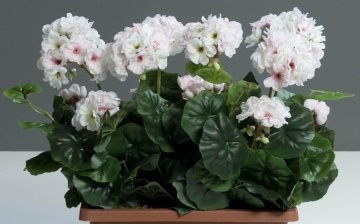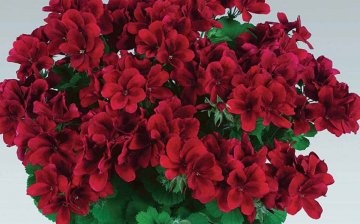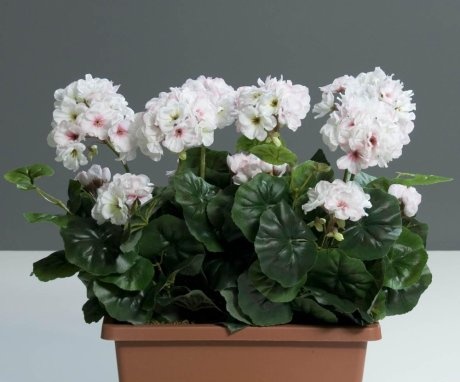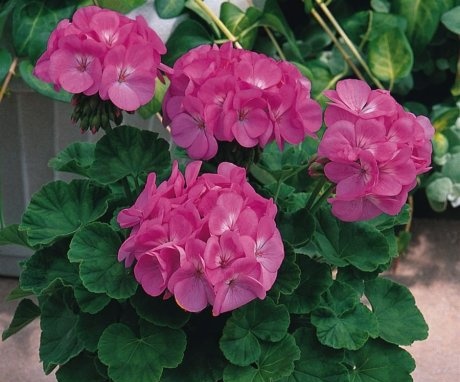Why geraniums are useful in the home for health, family and financial well-being
Geraniums or pelargoniums are flowering plants of the Geraniaceae family. Beautiful varieties are grown in rooms and flower beds. The names are considered interchangeable, but this is not entirely true. Accuracy is especially important when it comes to the health benefits of geranium in the home and its use in traditional medicine.
Why geranium is good for health
Pelargonium is a genus of heat-loving plants common in indoor floriculture and landscape design. The potted flowers, which many call geraniums, actually belong to the genus Pelargonium. True geraniums from the genus Geranium are not interbreed with. The differences are easier to see by comparing photos of indoor flowers, for example, zonal and large-flowered pelargonium, with a natural species - meadow geranium.
Who is who
Lack of attention to the systematic position and details gave rise to a real boom associated with the beneficial properties of room geranium. Almost all the medicinal properties that are now attributed to indoor plants are actually known for a long time. However, they are characteristic of natural species of the genus Geranium - meadow and blood-red.
All of the above does not mean that indoor and garden geraniums are not beneficial. Plants contain valuable chemicals and are used in folk medicine and everyday life. Only the intake of the preparations of these plants inside is not well understood, therefore it is not recommended.
The names of two different genera of the geranium family reflect the similarity of the fruits of plants with the beak of a stork and a crane. Meadow geranium is also called a crane. One flower of the same genus, growing everywhere, was called the common stork. The word pelargós in translation from Greek means "stork". If you observe the maturation of seeds of indoor geraniums, it is easy to see that they resemble the long and thin beak of a stork.
The confusion in the names has a long history, it is due to the fact that the founder of the botanical classification Linnaeus initially attributed geraniums and pelargoniums to the same genus. Much later it turned out that the family ties between these plants are not so close. These are two different genera within the same family.
The flower of geraniums and pelargoniums consists of 5 petals (except for semi-double and double varieties of indoor plants). Corollas of geraniums are actinomorphic, regular in shape, like a star. Pelargonium flowers are slightly asymmetric: the upper 2 petals differ in shape and location from the lower 3.
In nature, plants belonging to different genera do not interbreed. Therefore, geraniums are those flowers that bloom in forests, fields, meadows and wastelands. Pelargoniums flaunt on window sills and flower beds. The most popular varieties are derived from species P. zonal, P. royal, P. fragrant.
The benefits of a houseplant
Earlier, zonal geranium was called "bourgeois flower". There was no such window in the houses of the poor and the middle class, where pots with rounded flowering "heads": red, pink, white, were not standing. The reason for this popularity should be sought in the studies of biochemists and doctors of the past century. Experts have found that essential oils and phytoncides of room geranium kill bacteria, even tubercle bacillus.
The antimicrobial properties of geranium phytoncides have been verified in modern experiments.Researchers applied drops containing millions of Staphylococcus bacteria to geranium leaves. After 3 hours, most of the bacteria died. At a distance of 5 mm from the leaf, the bacteria died within 6 hours.
The phytoncidal properties of indoor plants are useful in homes with children, often sick elderly people. The aroma of geranium helps relieve headaches, nervous tension, fatigue, and normalize sleep.
There is a belief that unfaithful spouses do not like the smell of zonal geranium. The plant makes it possible to carry out the simplest "test for treason", but does not guarantee the accuracy of the result. Fragrant geraniums are also believed to repel flies.
A strong, pungent smell appears when you touch the leaves of zonal pelargonium. The aroma of royal geranium is subtler, more pleasant. If you rub the leaves of fragrant pelargonium, you can smell lemon, mint, ginger, lemon balm. Geranium (pelargonium) and its oil are used in aromatherapy. The sap of the plant is a local remedy for the treatment of otitis media.
To take advantage of the benefits of a houseplant, you need to purchase geranium oil from a pharmacy. Applied externally for dermatitis, burns, ulcers, eczema. Geranium oil is suitable for air disinfection for upper respiratory tract infections, inflammation of the pharynx, middle ear, and sinusitis. In oriental medicine, the remedy is prescribed topically for cervical cancer.
Geranium oil mixed with other substances treat varicose veins, added to cosmetics for skin and hair care. You can simply mix a few drops of the scented liquid with a face cream, shampoo, or balm.
Chemical composition
Geraniol is one of the main beneficial components in the composition of the leaves of the fragrant indoor geranium (pelargonium). It is a light yellow aromatic liquid, volatile alcohol, a substance from the terpenoid group. Geraniol has a rose scent and is found in the essential oils of geranium, palmarosa, lemongrass, and rose.
Other organic compounds in the leaves of aromatic pelargonium:
- tanning agents, tannins;
- organic acids;
- flavonoids;
- glycosides;
- phytoncides;
- coumarins;
- saponins;
- pectins;
- starch;
- gums;
- resin.
The leaves of a wild medicinal plant meadow geranium are rich in mono-, di- and polysaccharides. Contains alkaloids, flavonoids, anthocyanins, vitamins C, K, carotene, saponins. Carbohydrates, flavonoids, tannins and saponins are also found in the roots of the plant. The chemical composition of underground organs is enriched with catechins, phenolcarboxylic acids.
Those who are going to take advantage of the healing properties of geraniums should be attentive to the characteristics of different species. In most publications, far from official and traditional medicine, geraniums are credited with miraculous properties, without specifying which plant in question.
If we talk about geraniums in the room, then these are plants belonging to the genus Pelargonium. The medicinal herbs described in herbal medicine handbooks and manuals are basically two species of the Geranium genus. Plants are completely different, with different composition and properties.
It should also be remembered that when obtaining varieties and hybrids of pelargonium, some chemical components characteristic of natural species were lost. Or, substances not characteristic of plants of these types of substances appeared. For example, varieties of fragrant geranium have been bred that smell like apple, rose, caramel, peach, mint, nutmeg.
Experts classify interspecific varieties as Pelargonium x hortorum. Nobody is studying their chemical composition and medicinal properties. They are not bred for medical purposes.
Meadow geranium is found in nature on forest edges, in river valleys, in the shade near fences. Blood red geraniums prefer drier areas, southern slopes of mountains and hills. Herb is a medicinal raw material, roots are used less often. Real geraniums, their decorative forms and varieties, are also used in floriculture, but less often than pelargoniums.The flowers of the plant are lilac, purple with stripes, the leaves are carved, often reddish-brown.
Healing properties
The smell of fragrant pelargonium soothes the nerves, relieves headaches (not all types). The leaves of this plant, or rather essential oils, have bactericidal, antispasmodic, decongestant and wound healing properties.
Meadow geranium is a plant with disinfecting, astringent, anti-inflammatory and antitoxic effects. Used for insomnia, neuralgia, lung diseases. Alcohol tincture in folk medicine is prescribed for heart disease.
Pelargonium sidoides is a plant native to South Africa. The Zulu tribes have been treated with it for many centuries. The English physician C. Stevens brought the plant to Europe. Later, researchers at a German pharmaceutical company created an antimicrobial drug based on a plant extract.
How to use geranium in traditional medicine
Recipes describing the use geraniums, belong to wild plants of the Geranium genus, and not indoor pelargoniums. If it is indicated that geranium is used for any disease, then this is a type of G. blood-red or G. meadow. You can not replace medicinal plants with indoor plants in herbal preparations, infusions, decoctions.
The medicinal properties of wild geraniums are well studied, recipes for use can be found in many collections, for example, in the books of herbalists Pastushenkov. An extract of the roots of plants of the species Pelargonium sidoides, related to indoor geraniums, is used in medicine for infectious ENT diseases.
In folk medicine for colds, it is recommended to drip 3 drops of fragrant geranium leaf juice into each nasal passage three times a day. Fresh leaves are attached to the wrist for 30 minutes in case of hypertension, arrhythmias, circulatory disorders. The juice squeezed out of the aerial part of the geranium is applied to the back with osteochondrosis, radiculitis. Or they simply knead the leaves and apply them to the sore spot in the form of an application.
Contraindications
There are general contraindications and prohibitions on use due to individual intolerance. You can not use geranium for medicinal purposes for pregnant and lactating women, young children. The plant is contraindicated for those who have been found to be hypersensitive to geraniol and / or any other chemical component in the composition of the raw material.
An allergic reaction to geranium is manifested in the form of a runny nose, sore eyes, lacrimation, itching in the throat, and coughing. If such symptoms appear, then you need to immediately stop using the product. You should also be careful when choosing a herbal preparation for those who have exacerbations of gastrointestinal diseases, varicose veins and thrombophlebitis.
Potential harm
It should be remembered that all parts of some types indoor geraniums contain mild toxins. Contact dermatitis may occur when you touch the plant, use leaves for applications, or juice for instillation. Caution is required in all types of plant care, but especially when treating them.
Carefully! Geraniol and linalool in geranium leaves can cause vomiting, loss of appetite, and depression when ingested.
Geranium is relatively harmless to humans. However, hamsters, guinea pigs, rabbits should not get close to the juicy leaves. They are poisonous to small animals and cause skin burns.
The use of geranium and its oil in cosmetology
The essential oil is widely used in the cosmetic and perfume industry. A volatile liquid with a rose-like aroma is obtained from pink geranium and is used in aromatherapy, folk medicine, and cooking. The smell helps to strengthen the immune system, improves mood.
Geranium oil has the following effects:
- anti-inflammatory;
- antispasmodic;
- antiseptic;
- regenerating;
- invigorating.
In aromatherapy it is used to relieve fatigue and nervousness, lower blood pressure, fight insomnia and depression.The oil is used to treat acne, acne, cellulite, and a number of other cosmetic problems. Added to cosmetic creams, shampoos, massage products.
It is believed that the oil helps to slow down age-related changes in the skin: improve its tone and smooth wrinkles. It is enough to squeeze the juice from the leaves and freeze, and then wipe the face with cosmetic ice, or add a drop of oil to cosmetics for daily skin care.
Benefits for energy
Pelargonium, as a "fire extinguisher", copes with outbursts of aggressiveness. Experts assure that a beautiful indoor flower has strong positive energy. Pelargonium helps to strengthen family relationships, and single - to find a companion.
The energy of the flower is also aimed at increasing the financial well-being of the inhabitants of the house. In general, geranium is considered a desirable plant for enhancing the overall ambiance of a residential or office space. Pelargonium helps smooth out conflicts between people, protects from negative energy, and strengthens well-being.
Signs associated with geraniums
The emergence of a houseplant in the homes of Europeans happened at a time when the "language of flowers" was in use. Various omens and superstitions were associated with the type of flower, the color of the petals, the number of buds. The "language of flowers" was almost forgotten, but in recent decades has attracted attention again.
Examples of the most "tenacious" folk signs associated with geraniums on the window:
- Protection from ill-wishers, a barrier against envy.
- Well-being, good family relations.
- Attracts money.
- Makes a person more energetic.
- Depending on the color - to a wedding, a long-term relationship, to the birth of a child.
To believe or not to believe is everyone's personal choice. The now noticeable movement of geranium from the premises to the street has nothing to do with its positive or negative energy. Such is the fashion nowadays in landscape design. The choice fell on the "usual" zonal pelargonium, as a fast-growing, hardy, beautiful plant. It is preferable to grow new varieties and hybrids in the rooms, the flowers of which resemble tulips, roses, stars.
Depending on the location of the pot
The need to place indoor plants in areas with certain energy flows is dictated by non-Slavic Feng Shui teachings. An exception was made for white, pink and purple geraniums. You can place pots of these plants anywhere in your living room. It is better to put red geraniums on public display - on a window, loggia or balcony, so that it is noticeable from afar. So the flower will be able to better protect against ill-wishers and envious people.
However, you should think about the needs of the plant itself. Pelargonium needs good lighting, tolerates partial shading, stretches in the shade, turns pale, blooms poorly. Therefore, they choose a place for a pot with geraniums so that the plant is brightly lit for at least 6 hours a day. South facing windows will require shading at noon.
Depending on the color of the geranium
Folk omens and superstitions appeared at a time when only simple geraniums with red, pink and white inflorescences were available. How long-existing signs now relate to terry pelargoniums, painted in a wide variety of colors, is unknown.
It is believed that pink geranium inspires a person to be creative. Also flowers of this color are presented at the stage of love. In the old days, the bride received pink geranium as a gift as a symbol of a strong marriage.
Red pelargonium means passion and ardor in the “language of flowers”. The plant of this color helps to extinguish conflicts, in general, negative energy. Red geranium protects from envious people, the evil eye.
Geranium has long been considered the flower of love. Girls kept and carried bags of dried white petals in order to quickly find the narrowed one. Also, white geranium is a symbol of purity, purity, modesty. It is recommended to keep such a plant in a house where they cannot conceive a child.Pelargonium bush with white flowers and a faint smell can be put in the bedroom for those who suffer from insomnia.
Purple geranium is a symbol of goodwill, a sign of friendly relations. It is believed that such pelargonium will help maintain mutual respect, strengthen old ties, and make new friends.
Depending on the state of the flower
Beautiful, well-groomed pelargonium is a symbol of wealth and monetary success. According to the teachings of feng shui, the lush bloom of geraniums in the house where something bad happened is explained by the plant's ability to neutralize negativity, turn it into positive energy.
There is a belief that geranium stops growing if there are very serious problems in the house. The flower is not able to neutralize a large flow of negative energy, therefore it withers away. Another reason is the presence in the house of a thing with bad energy, spoken of to a bad effect. We must try to understand the reasons, remember from what moment the indoor flower began to fade. You can help geraniums by transplanting them into fresh soil.
Blooming pelargoniums are increasingly seen in offices. As for kindergartens and schools, this houseplant has long been allowed and recommended to be kept in children's institutions as safe, easy to care for and beneficial to health.
Reviews
-
Ekaterina:
“I love fragrant geranium, but it stretched out a lot for me. I put the pot on top of the better-lit kitchen window. My geranium has become more luxuriant. "
-
Love:
“I took up indoor flowers, found cuttings of dark red and pink terry pelargoniums. When my plants got big, I shared the shoots myself. And then something happened that made me believe in the omens associated with geraniums. The people to whom I gave the cuttings were evidently not too kind, because the geraniums perished both for them and for me. "
-
Valery:
“We grow red geraniums on an open balcony in boxes. It's so nice to go home from work and see beautiful flowers from afar. "
Video about the beneficial properties of geranium:












We have one pelargonium flower in our apartment, it grows in our bedroom on the windowsill. Since when touched, the flower begins to smell strongly, then we try not to disturb it and not tolerate, unnecessarily, a flower pot. Pelargonium flowers are very beautiful and if the plant is not disturbed, then it does not show its presence in the room in any way.
In the photo, such a beautiful and lush geranium, I grew more modest and for some reason often shed the lower leaves, the stem was bare. The fact that any plant brings good or bad luck, I do not believe, these are myths. The main thing is that the khazyaevs like it at home.
I had to read very different opinions about how useful it is to have geraniums in your home. Nevertheless, I have this plant on the windowsill, but this is more due to its unpretentiousness.
There are several types of geraniums growing in my house - fragrant, terry and ordinary. Fragrant in due time helped me to cure otitis media. My ear chilled, it hurt in the evening, I rubbed the leaf and put it in my ear (do not shove it inside !!!). By the morning it was much easier, I repeated it again and everything passed. I heard that the smell of geranium does not like people who have problems with nerves.